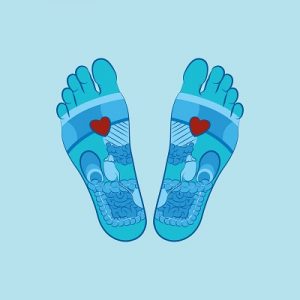 Reflexology, which is also known as the zone therapy, is an alternative medicine technique in which massaging, stroking, squeezing, pressing, rubbing and pushing on very specific areas of the feet, hands, and ears is applied to promote or stimulate beneficial effects to other corresponding remote parts of the body such as the vital internal organs (heart, liver, brain, stomach, bladder, sinuses, spleen, gall bladder, pituitary grand, adrenal gland, pancreas, kidneys, ureter, colon, small intestines, thyroid, bronchial tubes, coccyx, lungs, and appendix) and other essential systems (voice, neck, throat, eyes, ears, armpits, shoulders, arms, breasts, solar plexus, sciatic nerve, diaphragm, and Peyer’s patches).
Reflexology, which is also known as the zone therapy, is an alternative medicine technique in which massaging, stroking, squeezing, pressing, rubbing and pushing on very specific areas of the feet, hands, and ears is applied to promote or stimulate beneficial effects to other corresponding remote parts of the body such as the vital internal organs (heart, liver, brain, stomach, bladder, sinuses, spleen, gall bladder, pituitary grand, adrenal gland, pancreas, kidneys, ureter, colon, small intestines, thyroid, bronchial tubes, coccyx, lungs, and appendix) and other essential systems (voice, neck, throat, eyes, ears, armpits, shoulders, arms, breasts, solar plexus, sciatic nerve, diaphragm, and Peyer’s patches).
The intent is to improve the subject’s overall health of the body as a whole and the mind.
The American Association of Reflexologists claims that Reflexology results in improved blood circulation, detoxification of metabolic wastes, reductions of tension and the facilitation of the body’s capability to heal itself. The Associations also claims that Reflexology Massage is effective for back pain, migraines, infertility, arthritis and a long string of other mind and body problems.
Since studies and research failed to reach clinical conclusions about the effectiveness of Reflexology Massage, medical professionals of the Western persuasion have repeatedly expressed concerns that the belief in this practice may dangerously delay treatments of potentially serious health conditions. They have even resorted to calling reflexology’s claim to maneuver energy (gi) pseudoscientific as there is no scientific evidence for the existence of life energy, crystalline structures or pathways in the human body.
In the United States, the same medical critics and others disapprove of the lack of medical training and the short duration of training such as it is. They further disparage over the fact that there exists no central regulation for accrediting and licensing Reflexology Massage therapists. Conversely, several European countries, among them Switzerland, require reflexologists to be trained and licensed medical practitioners with a thorough understanding of anatomy and physiology.
However, based on ancient Chinese healing, reflexologists claim that the human body contains an invisible energy field which is the life force or the gi and they insist that a blockage or an obstruction of this life force prevent or puts off the body’s natural inclination for self healing and the improvement of health and wellness.
Dr. William H. Fitzgerald, an ear, nose and throat specialist and his partner Dr. Edwin Bowers are said to have been the first to pioneer reflexology in the United States in 1913. Referring to their theory as “zone therapy”, Drs. Fitzgerald and Bowers claimed that, in fact, imposing pressure at some very specific sites of the body provides analgesic and anesthetic effects on other distant parts.
In the 1930s and 1940s, Eunice D. Ingham, a nurse and a physiotherapist, declared that the hands and feet are particularly receptive and proceeded to diagram the entire body into associated impulse or reflex points on the feet. By doing so, Ingham changed the previously spoken of “zone therapy” to “reflexology” or “reflexology massage” and her charted reflexes are still followed today.
The overall effect of Reflexology is that it balances the body and creates the environment for the body to heal itself.






